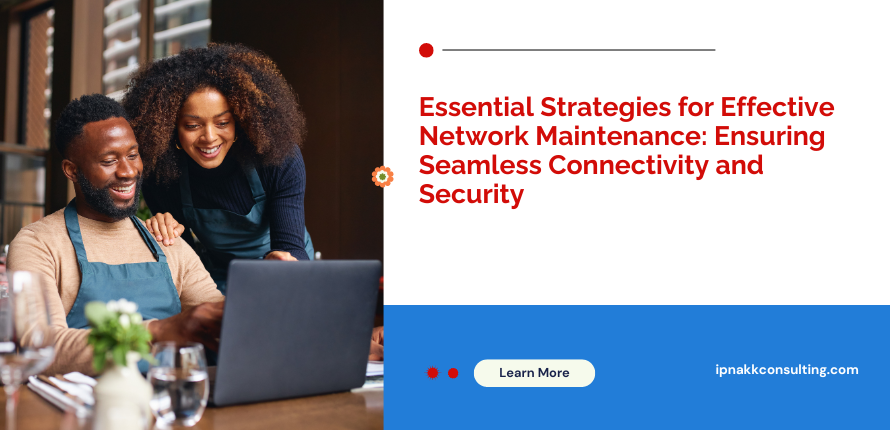Introduction
The maintenance of networks is all about ensuring that businesses, organizations, and even individuals run without any form of interruption. Effective network maintenance helps in keeping downtime at bay, performance up to the mark, or helping to protect against new threats—the backbone of smooth, efficient, and secure IT. Therefore, this paper delves into some very important strategies for network maintenance, specifically how to maintain seamless connectivity and robust security.
Importance of Network Maintenance Task
Network maintenance entails a collection of activities aimed at ensuring a computer network’s serviceability and integrity. Network maintenance will consist of regular monitoring and troubleshooting, software updating, and optimization in hardware performance. In the absence of proper maintenance, networks may encounter such problems as downtime, slow performance, or security attacks. Proper network maintenance actually avoids such situations from occurring and therefore ensures the safety and reliability of the network.

Main Benefits of Regular Network Maintenance:
- Downtime Minimization: With regular maintenance, issues can be detected before they result in major disruptions.
- Performance Enhancement: The network is maintained through constant updates and optimization to stay in excellent condition.
- Security Improvement: Routine checks and updates prevent the network from the latest threats.
- Cost Efficiency: Preventive maintenance lowers potential expensive emergency repairs.
- Compliance: Regular maintenance guarantees that the network operates in accordance with industry regulations and standards.
Key Components of Network Maintenance
The key components of network maintenance are multifaceted, and its most important ones include:
1. Network Monitoring
Constant monitoring of a network ensures that potential problems are pinpointed before an impact can be created. This is made possible by monitoring tools that maintain performance data, for example, latency to bandwidth usage and error rates. With the acquired capability, they can alert operations personnel in real-time in case something goes awry.
Best Practices in Network Monitoring
- Implement the use of automatic tools for network monitoring that will facilitate provision of real-time data and alerts.
- Baselines Establishment: Understand what is normal in your network, which will easily help you to spot variances.
- Regular review of logs: Logs might provide good clues on the health and performance of the network.
2. Software and Firmware Updates
Keeping the software and firmware in routers, switches, firewalls, and other network devices up to date is of paramount importance for security and performance. More often than not, updates entail patches to fill the security holes and improvements that would enhance the device operation.
Some Best Practices for Effective Updating
- Automate the Update Process: As much as possible, enable auto updating to ensure timely updating.
- Test Before Deployment: The deployment over the network should be made after testing the updates in controlled environments so that compatibility issues can be avoided.
- Schedule Regular Checks: There should be a regular setting to check the availability of any kind of updates, which need to be applied and followed.
3. Network Security Protocols
Security forms an integral part of network maintenance. A strong formulated security protocol helps keep the network safe from unauthorized access to malware and other cyber threats.
Critical Security Controls
- Firewalls and Intrusion Detection Systems (IDS): Implement, Update, and Maintain firewalls and IDS to monitor and secure potential threats.
- Encryption: Implement strong methods of encryption for data in transit and at rest to ensure that the information is not accessed by unauthorized personnel.
- User Access Controls: Implement strict user access controls to assure only authorized personnel will be able to access sensitive areas of the network.
4. Hardware Maintenance
This is the type of maintenance that looks into ensuring all physical network components, for instance, servers, routers, and switches, are working appropriately. Periodic hardware checks and upgrading are necessary to avoid failure of such devices rendering your network redundant.
Hardware Maintenance Tips
- Regular Inspections: Periodically check on hardware to identify potential weak points that might fail.
- Proactive Replacements: Replace aging hardware before it fails to avoid unexpected downtime.
- Backup Power Supplies Ensure the connection of all crucial network devices to an uninterruptible power supply to prevent any possible downtime and disturbance.
Data Backup and Recovery
A strong data backup and recovery mechanism significantly supports quick recovery from network collapses and other security issues. Regular scheduling of backups ensures that recovery processes are both fast and at minimum downtime with no loss of data.
Data Backup Best Practices
- Automate the process: Use automated backup solutions to ensure that data gets regularly and consistently backed up.
- Offsite storage: Store backups in a secure offsite location to protect against physical damage or theft.
- Test recovery procedures: Perform periodic test recovery procedures to ensure that, in case a restore is necessary, the backups will be restored quickly and without trouble.
Setting Up a Preventative Maintenance Schedule
A preventative maintenance schedule allows for proactivity in maintaining the network by constantly monitoring, updating, and tuning it. These schedules should be tailor-made in regard to the specific needs of the network, encompassing every aspect that may be required to maintain a network.
Steps in Coming up with a Good Maintenance Schedule
- Assess the Needs of the Network The first step to planning the maintenance of your network is determining what your specific needs are for this maintenance in terms of its size, complexity, and criticality.
- Scheduling Set a schedule for maintenance works on a daily, weekly, monthly, and annual routine basis.
- Setting Priorities Rank maintenance tasks according to the order of importance and the potential consequences of not carrying them out.
- Assign Responsibility The responsibilities for a given maintenance task are to be assigned to specific people, ensuring accountability.
- Document Procedures Clear documentation of all the maintenance procedures assures consistency and accuracy.
Common Network Problems and Their Solutions
Troubleshooting of General Network Issues Even with the best maintenance practices, network problems are still bound to occur. The preparation to troubleshoot some common problems goes a long way in maintaining network performance and security.
Problem
- Slow Network Performance: Mainly caused by high traffic, old hardware, or software issues. Generally, it can be mitigated in a solution that simply involves hardware upgrade, traffic optimization, and software updates.
- Problem in Connectivity: Hardware failures or faults from interference can result in misconfigured settings.
- Solution Check on configurations, replace the failed hardware, and minimize the sources of interference.
- Security Breaches The breaches are as a result of outdated security protocols or human error.
- Solution Keep updating the security measures and training employees on good security practices.
Role of Documentation in Network Maintenance
Proper documentation is the backbone of the network maintenance. It keeps track information of network configuration, addition, and servicing over the years, and the procedures entailed in troubleshooting several issues within the network. The documentation has the following components:
- Network Topology; the diagram shows the view of the structure of the network with all devices, together with their connection.
- Configuration Files: Keeps tracks of all configurations on devices; routers, switches, and firewalls.
- Maintenance Logs Records of all maintenance work, updates, repairs, and inspections carried out.
- Troubleshooting Guides Step-by-step guides to resolve common network problems.
Training and Educating for Network Maintenance
Regular training and education are very important for keeping the IT staff up-to-date with the modern techniques and technologies related to maintaining a network. The better-trained the workforce, the better they can carry out complex maintenance tasks and respond optimally to threats.
TRAINING RECOMMENDATIONS
- Certification Programs: Encourage staff to go through certification programs like CompTIA Network+, Cisco CCNA, or any equivalent program.
- Regular Workshops: Have workshops periodically on recent network maintenance tools and techniques.
- Online Resources: Utilize the option of taking online courses and leveraging resources on their own.
Outsourcing Network Maintenance: Pros and Cons
Some companies prefer to keep a third-party expert contractor for network maintenance. However, a company cannot outsource its IT needs before considering the benefits and the risks.
Benefits:
- Outsourced Expertise: The firm may access specialized knowledge belonging to highly qualified professionals.
- Savings: Elimination of in-house IT staff and infrastructure; only what is used is paid for.
- Scalability: Depending on the organizational needs at that particular moment, one can either scale down or scale up services.
Negative Points:
- Less control: A bit decrease in control over network maintenance processes and decision making.
- Security Risks: Dangers that may emanate from giving other parties access to sensitive network data.
- Over-Reliance: Over-reliance on third-party vendors where, in case of their failure, is a disastrous affair.
Future of Network Maintenance
Network management, like any other tech field, is also always evolving. The advancement of technologies like automation, AI, and IoT is changing the ways networks are maintained.
Upcoming Trends in Network Maintenance
- Automation: Use of automated tools to complete routine maintenance tasks, thus lowering the need for manual efforts.
- AI and Machine Learning: Artificial Intelligence-enabled tools that may predict network issues even before their incidence and take preventive measures.
- Integration of IoT: With IoT integrated into networks, it brings a huge number of IoT devices; for these, new strategies and tools for maintenance are needed.

